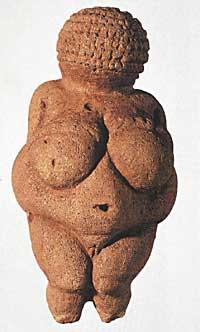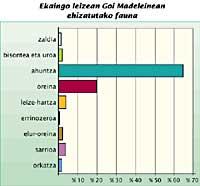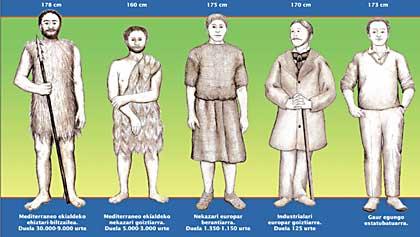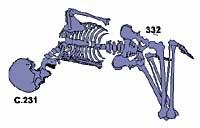Height, reflection of the time

The analysis of the evolution of height throughout history throws eye-catching data. For example, the men and women of the Paleolithic era were very high, higher than many expected. And, according to the trend of recent years, it seems that height has been growing steadily.
But it's not so, long ago people were almost taller than now. And if height and lifestyle are related, what does that mean? That the Paleolithic lived better than later?
The first ancestors of the European population reached the continent about 40,000 years ago. They came from Africa and, according to the footprints, they were long and slender, especially men. Its average length was 176 cm and its estimated weight is 67 kg. The women, for their part, were smaller and wider, with 158 cm of height and 54 kg of weight.

It does not seem that those human beings had an easy life. They had to deal with a very cold climate, especially about 18,000 years ago, when the lowest temperatures were. However, they succeeded in replacing the Neanderthal, men long extended in Europe.
At the end of the glaciation, the climate was very mild. For example, a. C. C. In the years 5.400 to 3.000 the atmosphere was even more temperate than now. When tempering, the ecosystem changed: what used to be a steppe was filled with birch and pine trees, and later, in the Bronze and Iron Ages, oak and beech trees spread. At the same time, mammals increased.
By changing the climate and ecosystem, man lost height. The men of Neolithic end had an average of 16 cm below those of the Upper Palaeolithic. Likewise, after the study of skeletons, experts have observed morphological changes during this period. For example, in the Upper Paleolithic the two sexes were very different morphologically and with time dimorphism was decreasing. On the other hand, the proportion of extremities and skull varies with the trunk.
Lights and shadows of agriculture
However, the decline was not due to climate tempering. At the same time, the human being stopped being a hunter-gatherer and learned to till the ground and grow the animals. It is clear that the conversion in sedentary and peasant had a great influence on food and life. And that was reflected in height.

The food consumed in the paleolithic was well adapted to the digestive system of man and to the energy needs of the time. These foods were rich in protein and fiber and did not take refined carbohydrates. At the end of the Glaciation, a great variety of foods were introduced into the diet, such as the Mesolithic, in which abundant fish were consumed, and even plants that did not exist before. However, in the Neolithic diet is impoverished.
In addition, during the period between the Paleolithic and the Neolithic, the density of the populations increased, while the diseases and struggles increased.
In the Neolithic the populations were even denser, 10-50 times denser than in the Palaeolithic. For food for all, they planted cereal in large areas and grew livestock. However, they ate between 10-20% less meat than in the Upper Paleolithic.

The life of the peasants was no more tender than when the man had to go hunting and collect fruit. The agricultural tasks were hard and depended on the harvest: when the harvest was lost they suffered from hunger and had to look for alternatives to get food.
Life was especially hard for women. The first menstruation occurred at an earlier age than in the Paleolithic period, so it was earlier to have offspring, with less difference between one pregnancy and the next. As a consequence of all this, women died earlier than men. However, men did not live longer than the Palaeolithic.
Historical incidences
In other times there were also significant decreases in average height. For example, from the first century to the second after Christ there was a great decline, although many thought that the time of the Roman Empire should be good. However, in some respects, it was not such a sweet time. It must be taken into account that then the wars were frequent, the cities were unhealthy and the plagues spread. All this was reflected in height, among others.

After the collapse of the empire, V and VI. For centuries, the men and women of Europe were longer than those of the previous centuries. The experts do not know very well why it happened, but it seems that thanks to the migrations new agricultural techniques were obtained and, helped by a mild climate, the livestock grew fast and the crops were good. The density of the populations also decreased. Everything seems to indicate that they had good health, and that is why they were so high. VII. The inhabitants of the twentieth century were smaller than the previous ones.
Then, in addition, the climate cooled and began the so-called Little Ice Age. The humidity, the lack of hygiene, the high density of the villages... all were beneficial for the appearance and spread of diseases. The black plague was especially hard in the fourteenth century. In the twentieth century it is estimated that, for example, in Italy it killed half of the population and in all Europe a third. In Asia it also spread a lot.
Neither did America escape the plagues. The bacteria, parasites and viruses carried by the European conquerors caused thousands of deaths on the continent. However, the diseases were not unidirectional, but they came to Europe not only from America, but also from far from Asia, with the conquerors returning home.

The wars, diseases and low agricultural productions affected the average height of the population and, for example, the XVII. In the eighteenth century the average descended notably. In fact, the temperatures of the time were very low, many European countries entered the Thirty Years War and spread contagious diseases. The situation did not improve much later, so the man of the industrial revolution was no higher than 2,000 years earlier.
It should be noted that the farther he lived from the cities in those times, the greater the possibility of one of them reaching a height determined by genetics. And that was the case in Vienna, London and also in Tokyo. Although at present there is a direct relationship between height and per capita income in general, it was not so before. Before the industrial revolution and during the first years of the revolution, life near the place where food was produced or food self-production was a nutritional benefit.
Thus, the rural population was, in most cases, higher than that of citizens, and enjoyed better nutrition than that developed in poorly developed territories. For example, Irish peasants had more and better food than the inhabitants of the English cities at the beginning of the industrial revolution. In North America, those in the southern states had better health than those in the north, and in 1830, for example, North American peasants were higher than professional workers in the city.
Measure of well-being

These examples demonstrate the direct relationship between quality of life and height. To know the height of ancient humans, researchers have measured the bones of tombs. There is no need for a complete skeleton, just the femur.
Fortunately, the femur is one of the best preserved bones of the skeletons, it is the longest bone in the body and measures about a quarter of the person. Researchers XVI and XVII. Armor of knights of centuries has also been used to calculate its height.
In later times, the army recruiting lists are an important source of data. In them, the relationship between height and lifestyle throughout time is clearly seen. In addition, the children of rich families fit in command posts, and it is evident that they were higher than poor citizens. Unfortunately, in these lists only data of men are collected.
These investigations have been carried out mainly at European level. But they have also been carried out in the US, where the data on the sale of slaves have served to analyze the relationship between height and quality of life. Apparently, slaves suffered the lack of small food, and before selling them they gave them good food to have better appearance and health and get better price on sale. Consequently, American slaves were higher than those in Africa, and many whites of that time. In fact, they were on average as high as the lords of Europe.
From there, XVIII and XIX. For centuries, the North American population was longer than the European population. In the New World there was abundant land and wealth to exploit. On the contrary, in the old continent, the differences between classes were enormous and the lower levels of society were very hungry. Thus, the high level youth who entered the American army were 19 centimeters higher than those of the London Bass.

Since the last century, both in North America and Europe, the population has been growing. In recent years in the US. This extension has diminished and in Europe those of the new generations are still higher than the previous ones.
Today, the highest are Dutch and Scandinavian, but those in southern Europe are extending faster. For example, although the Dutch are now 10.5 centimeters longer than the Portuguese, according to experts, the Portuguese will be captured within a few years.
How much more will man lengthen himself? Where is the limit? Researchers are seeing how racial differences are drastically reduced if we compare health and nutrition states.
However, there is a genetic limit and it is true that being very high affects health negatively; the problems of the spine, for example, are common among tall people. This is partly because the furniture, houses, or vehicles are designed for people of medium height. Therefore, architects and designers should take into account that people are lengthening and extending. Who knows to what extent!

Lourdes Herrasti: “A generation takes us away from hunger”
Lourdes Herrasti is a researcher at the Aranzadi Science Society and we met with her to learn about the historical evolution of the height of the inhabitants of Euskal Herria. The talk has been really interesting and we have been fascinated by a phrase. Lourdes Herrasti has told us, among other things: “ In The silence of the lambs, Hannibal Lecter tells the character who plays Jodie Foster: «A generation takes you away from hunger». And that’s a round truth.”
In the deposits you investigate, will you not measure the length of the bones? Hence do you draw conclusions?
Yes, of course. Whenever we can measure the skeletons. However, we cannot draw absolute conclusions. One of the problems is that in the old deposits it is difficult to find long bones, like the femur, complete, so it is not always possible to calculate the height.
If there is no femur, we calculate from other long bones, such as the length of the humerus. But, undoubtedly, the femur is the most reliable, since the length of arms and legs is not always proportional.
On the other hand, we find few tracks. So, to what extent do these few represent an entire group? And the groups the population of those places? In fact, there is a lot of difference between living in the mountain or in the plain, since in general those of the plain eat better and more. Two main factors influence the height of a person: one is the genetics and the other the feeding.
And throughout history always appears this relationship between lifestyle and height?
Look: one of the most important sites we have studied is that of San Juan before Portam Latinam, in Álava. It is a Neolithic necropolis of 5,000 years ago, in which there are corpses of about three hundred people. Of them, one hundred are children under seven years, so they do not serve to perform these calculations. The rest has been measured, with an average length of 1.66 m for men and 1.60 m for women.
There is a very striking case: he was a 1.88 m long man. But that means nothing. Today there is a big difference between each other, but we use the average to carry out research. In this case the same thing also happens. Besides this man of more than 1.80 m, there are others of 1.70 m, but the average is 1.67 m.
Therefore, they were similar to those found in other European sites. And in later times?
The truth is that we don't have too much data. The medieval necropolis were only used at that time, but thereafter the corpses of people of different ages were buried in the same place and the bones appear mixed. It is difficult to know when they are exactly. That is why we cannot draw great conclusions. However, although there are incidents, XX. The average height does not vary much until the twentieth century.
Lately, XX. We are studying the skeletons of the 20th century Civil War in Castilla, Asturias... And it's amazing to see how small women were. The average distance was about 1.50m and men are also difficult to overcome 1.65m.
It is clear that food and lifestyle directly affect the height, and until the end of the dictatorship and the improvement of the economic situation, people have not had the opportunity to grow. Today, however, young people are much higher than their parents.





